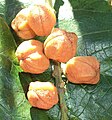Croton sylvaticus
| Croton sylvaticus | |
|---|---|

| |
| Scientific classification | |
| Kingdom: | Plantae |
| Clade: | Tracheophytes |
| Clade: | Angiosperms |
| Clade: | Eudicots |
| Clade: | Rosids |
| Order: | Malpighiales |
| Family: | Euphorbiaceae |
| Genus: | Croton |
| Species: | C. sylvaticus
|
| Binomial name | |
| Croton sylvaticus Muell. Arg.
| |
Croton sylvaticus is a tree in the family Euphorbiaceae. It is commonly known as the forest fever-berry. These trees are distributed in forests from the east coast of South Africa to Tropical Africa. It grows 7–13 metres (23–43 ft) in height, occasionally up to 30 metres (100 ft), in moist forests, thickets and forest edges at altitudes of 350–1,800 metres (1,100–5,900 ft).
Flowers and fruit[]
Greenish cream flowers, up to 3 millimetres (15⁄128 in) long (all male or female or mixed flowers), in racemes, 10–30 centimetres (4–12 in) long. Fruit, light green when young, turning to orange or red, trilobed, oval in shape, hairy.
Uses[]
Used as a general timber, for poles, posts and as a fuel.
Phytochemistry[]
Mwangi et al 1998 find β-caryophyllene oxide, α-humulene-1,2-epoxide, , β-sitosterol and stigmasterol in the extracts.[1][2][3] This contrasts with Sadgrove et al 2019 who find almost entirely bicyclogermacrene in the essential oil.[3]
Traditional medicine[]
Sap from leaves is used for healing cuts, bark is used in the treatment of malaria, a decoction from the bark of the roots is taken orally as a remedy for tuberculosis, an infusion of the leaves acts as a purgative.[4]
Gallery[]

Crown
Young stem
Leaves
Flower buds on inflorescence
Flower
Fruit

Seeds
See also[]
References[]
- ^ Maroyi, Alfred (2017). "Traditional usage, phytochemistry and pharmacology of Croton sylvaticus Hochst. ex C. Krauss". Asian. Hainan. 10 (5): 423–429. doi:10.1016/j.apjtm.2017.05.002. ISSN 1995-7645.
- ^ Mwangi, Julius Wanjohi; Thoithi, Grace Njeri; Kibwage, Isaac Ongubo (2010-01-11). "Essential Oil Bearing Plants from Kenya: Chemistry, Biological Activity and Applications". . Washington DC: American Chemical Society. pp. 495–525. doi:10.1021/bk-2009-1021.ch027. ISSN 0097-6156.
- ^ a b Moremi, Matenyane P.; Makolo, Felix; Viljoen, Alvaro M.; Kamatou, Guy P. (2021). "A review of biological activities and phytochemistry of six ethnomedicinally important South African Croton species". Journal of Ethnopharmacology. (Elsevier). 280: 114416. doi:10.1016/j.jep.2021.114416. ISSN 0378-8741.
- ^ Field Guide to Common Trees & Shrubs of East Africa by Najma Dharani, Struik Publishers, Cape Town, South Africa, 2002, ISBN 1-86872-640-1
- Pooley, E. (1993). The Complete Field Guide to Trees of Natal, Zululand and Transkei. ISBN 0-620-17697-0.
- Croton (plant)
- Flora of South Africa
- Flora of Africa
- Afrotropical realm flora






